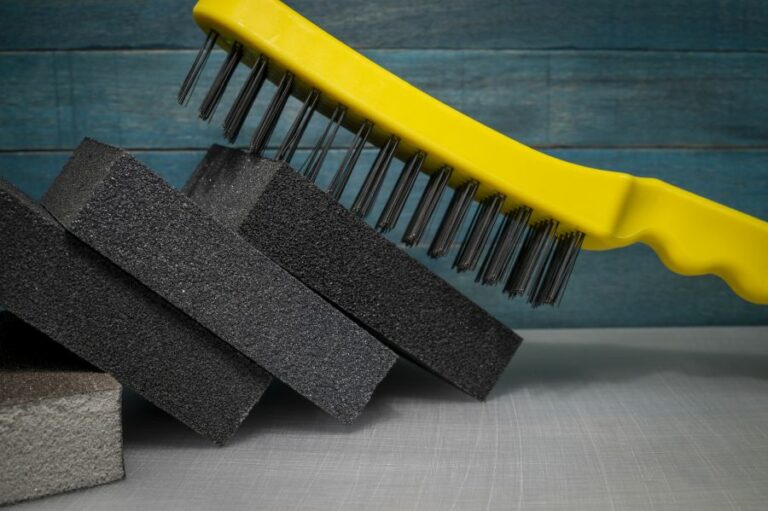Caulk And Seal Method For Consistent Paint. What Pros Say
Are you tired of inconsistent paint coverage and unattractive gaps in your home improvement projects? I’ve got you covered. The caulk and seal method is the ultimate solution for consistent paint application, leaving your DIY project flawless and professional-looking.
Caulk and seal method for consistent paint:
The caulk and seal method is a technique used in painting to achieve smooth, consistent results by filling gaps, cracks, and inconsistencies in the surface. This method enhances durability, weather resistance, and energy efficiency. Key steps involve selecting the appropriate caulking compound, preparing the surface, applying caulk, and painting over the sealed area.

Want to achieve a flawless paint finish with sharp and clean edges? Our comprehensive guide on the caulking and sealing method will help you achieve professional results easily. Keep reading to learn the secrets of a consistent paint job, perfect for beginners and experts alike!
Contents
- 1 Consistent Paint Results with Caulk and Seal Technique
- 2 Achieving Flawless Paint Lines Using Caulk
- 3 Simultaneous Caulking and Painting: Is It Possible?
- 4 Best Non-Shrinking, Paintable Caulk for Professional Results
- 4.1 • Acrylic Latex Caulk: A Suitable Choice for Many Applications
- 4.2 • Siliconized Acrylic Latex Caulk: A Better Option for High-Moisture Areas
- 4.3 • Elastomeric Caulk: The Ultimate in Flexibility and Paintability
- 4.4 • Choosing the Right Caulk for Your Project
- 4.5 • Application Tips for Long-Lasting Results
- 5 Top Caulk Choices for Professional Painters
Consistent Paint Results with Caulk and Seal Technique
• Introduction to Caulking and Sealing
Caulking and sealing is essential stages in the painting process, providing smooth, professional results by eliminating gaps, cracks, and inconsistencies in the surface. Additionally, this method offers increased durability, weather resistance, and energy efficiency by preventing moisture and air infiltration.
• Choosing the Right Caulking Compound
Selecting the appropriate caulking compound is crucial, as it determines the overall longevity and effectiveness of the application. There are four main types of caulking compounds:
- Acrylic Latex: this water-based caulk is easy to apply, clean, and paint. It is ideal for indoor applications and offers mildew resistance. The North Carolina State University recommends this type of energy-efficient home design.
- Siliconized Acrylic Latex: this offers greater flexibility and adhesion compared to basic acrylic latex. It can be used for both indoor and outdoor applications.
- Silicone: This is a waterproof caulk that provides excellent flexibility and durability. However, it is not paintable, making it less ideal for a consistent paint finish.
- Polyurethane: this is a high-performance sealant that offers excellent adhesion and flexibility for a variety of substrates. It is paintable but requires more skill to achieve a smooth finish.
For a consistent paint finish, I recommend using siliconized acrylic latex or polyurethane caulking compound.
• Tools and Materials Required
Before beginning the caulk and seal method, gather the necessary tools and materials:
- Caulking compound
- Caulking gun
- Utility knife
- Painter’s tape
- Damp cloth or sponge
- Paintbrush, roller, or sprayer (for paint application)
• Preparing the Surface
Proper surface preparation is essential to achieve a consistent paint finish. Follow these steps to prepare the surface:
- Clean the surface: Remove any dirt, dust, or debris from the area to be caulked, as they can interfere with adhesion.
- Remove old caulk: If applicable, use a utility knife to carefully scrape away any old, damaged, or loose caulk.
- Apply painter’s tape: This step is optional but recommended for beginners. Applying tape on either side of the gap or joint will help achieve clean, straight lines.
• Applying the Caulk
Follow these steps to apply the caulking compound:
- Load the caulk gun: Cut the tip of the caulking tube at a 45-degree angle, pierce the inner seal and insert it into the caulking gun.
- Apply steady pressure: Hold the gun at a 45-degree angle and run it along the gap or joint, applying consistent pressure to the trigger.
- Smooth the bead – With a damp cloth or sponge, smooth the bead of caulk along the joint, removing any excess.
- Remove painter’s tape: While the caulk is still wet, carefully remove the tape to reveal clean lines.
- Allow to dry: Check the instructions on the caulk’s packaging for the recommended drying time before proceeding with the paint application.
• Painting Over Caulk
- Choose the right paint: Ensure compatibility between the caulking compound and paint. Most acrylic latex and polyurethane caulks can be painted with latex or water-based paints.
- Apply primer: If the caulk is not a paintable grade, apply a primer specifically designed to bond with the caulk.
- Apply the paint: Using a paintbrush, roller, or sprayer, apply the paint over the sealed surface in consistent strokes, ensuring even coverage.
• Tips for Success
- Practice using the caulking gun on a scrap piece of material before applying it to the actual surface.
- Start with a small gap and ensure a clean, smooth bead before moving on to larger areas.
- Apply caulk on a dry, temperate day to ensure optimal curing conditions.
- Paint within a reasonable time frame after caulking, as prolonged exposure to environmental factors can negatively impact the finish.
• Conclusion
The caulk and seal method can significantly improve the quality, longevity, and consistency of painted surfaces.
By carefully selecting the right caulking compound, properly preparing the surface, and following the application steps, anyone can achieve professional, seamless results while also improving their home’s overall energy efficiency and weather resistance.
Achieving Flawless Paint Lines Using Caulk
Creating perfect paint lines can be a challenge, especially for those who lack experience in painting. One method that ensures clean and straight lines when painting is by using caulk.
Caulking is a technique that not only provides a professional finish but also prevents the paint from bleeding under the tape.
• Choose the Right Tape and Caulk
Selecting the right tape and caulk is crucial for clean paint lines. Here are my recommendations:
– Tape
I recommend using painter’s tape, specifically the blue or green kind designed for delicate surfaces. These tapes have lower adhesion and are less likely to damage the surface or leave a sticky residue after removal.
- Blue painter’s tape: This is a good all-purpose tape with medium adhesion. It is perfect for most painting projects.
- Green painter’s tape: This tape has lower adhesion and is suitable for delicate surfaces, such as freshly painted walls or wallpaper.
– Caulk
For this technique, I recommend using clear or white painter’s caulk. It is water-soluble, easy to work with, and dries quickly. Ensure that the caulk is easily paintable, as some types may be resistant to paint.
• Prepare the Surface
Before applying the tape and caulk, prepare the surface by cleaning it thoroughly. Remove dust, dirt, and grease from the surface using a damp cloth or sponge. Allow the surface to dry completely before proceeding.
• Apply the Tape
To achieve precise paint lines, you must apply the tape correctly. Here’s how:
- Measure and mark the area where you want a straight paint line.
- Apply the tape along the marked line, leaving about a 1/8-inch gap between the tape and the area to be painted. This provides space for the caulk.
- Press the tape firmly with your fingers or a small tool, like a putty knife, to remove air bubbles and ensure proper adhesion.
• Apply the Caulk
Once the tape is in place, apply a thin bead of caulk along the edge of the tape. Use the following steps:
- Cut the caulk tube’s tip at a 45-degree angle to create a small opening.
- Load the caulk tube into a caulking gun.
- Apply a thin bead of caulk along the edge of the tape, ensuring it fills the gap between the tape and the area to be painted.
- Immediately smooth the caulk with your finger, wiping off the excess on a clean cloth or towel.
• Allow Caulk to Dry
Allow the caulk to dry for the recommended time stated on the packaging, usually around 30 minutes to 1 hour. Do not proceed with painting until the caulk is completely dry.
• Paint the Area
After the caulk dries, paint the area using a brush or roller. The caulk creates a barrier that prevents the paint from bleeding under the tape, resulting in clean and precise paint lines.
• Remove the Tape
Once the paint is fully dry, carefully remove the tape. Start at one end of the tape, and slowly peel it back at a 45-degree angle to avoid tearing or damaging the paint. If any residue remains from the caulk, gently wipe it away with a damp cloth.
• Final Thoughts
Achieving perfect paint lines with caulk is a simple yet highly effective technique. By choosing the right tape and caulk, properly preparing the surface, and following the steps outlined above, you can ensure clean and straight lines in your painting projects.
Remember to practice patience and precision when using this method, as rushing or cutting corners may lead to less-than-perfect results. And finally, like any skill, practice makes perfect so keep honing your technique for the best outcome.
Step | Description |
|---|---|
1 | Measure and mark the area where you want the paint line. |
2 | Apply painter’s tape along the edge of the marked line, leaving a small gap for the caulk. |
3 | Apply a thin bead of painter’s caulk along the edge of the tape, filling the gap. |
4 | Using a wet finger or a caulk smoothing tool, smooth the bead of caulk to form a clean edge. |
5 | Allow the caulk to dry according to the manufacturer’s instructions. |
6 | Paint over the caulked area and remove the painter’s tape before the paint dries. |
7 | Allow the paint to dry and enjoy your perfect paint lines! |
Simultaneous Caulking and Painting: Is It Possible?
If you’re wondering whether you can caulk and paint at the same time, the short answer is no. It’s best to wait for the caulk to dry before starting the painting process.
• Importance of Allowing Caulk to Dry Prior to Painting
Caulking is applied to seal gaps or joints found in various surfaces, like walls, windows, doors, and trim. It helps increase insulation and create a professional, finished look. However, applying paint over wet or even tacky caulk will result in a poor result.
The paint needs to adhere to the surface for good coverage, but it will not stick to wet caulk properly.
Furthermore, wet caulk may impact the color and aesthetics of your paint. If the paint dries before the caulk, it may lead to cracks, gaps, or uneven distribution. To achieve a polished and seamless look, it’s crucial to let the caulk dry completely before painting.
• Waiting Time Between Caulking and Painting
Before painting, wait for the caulk to dry to ensure a smooth and lasting result. A general rule of thumb is to wait at least 24 hours for the caulk to cure thoroughly.
However, the drying time may vary depending on factors such as temperature, humidity, and the type of caulk being used. Refer to the manufacturer’s instructions for the recommended drying time for your specific caulking product.
Higher humidity and low temperatures may extend the drying period, while warm and dry conditions can expedite the process.
Silicone-based caulking may take longer to dry than latex or acrylic caulk. Some caulking products labeled as “paintable” may have a shorter waiting time, so make sure to verify the product’s specifications.
• Choosing the Right Caulk for Your Project
There are several types of caulks available on the market, each with its applications and benefits. The two main types you’ll encounter when working on a painting project are:
- Latex or Acrylic Caulk: Water-based, easy to apply, and easy to clean. Suitable for indoor use and works well for painting projects. Latex caulk adheres well to porous materials like wood and drywall, and it’s paintable. It remains flexible after drying and has less odor than silicone-based caulk.
- Silicone Caulk: Highly durable, waterproof, and resistant to extreme temperatures. Silicone caulk is ideal for places that experience constant exposure to water, such as bathrooms and kitchens. Because of its rubbery texture, the paint might not adhere well to silicone caulk. If you need to use silicone caulk for your project, make sure you choose a paintable variety.
When choosing caulk for your project, consider factors such as the application area, exposure to moisture, and the need for paint adhesion.
• Best Practices for Caulking and Painting
Here are some tips to help you achieve a quality result when it comes to caulking and painting:
- Clean the surface: Thoroughly clean the area where you plan to apply the caulk. Remove any dust, dirt, or debris to ensure proper adhesion.
- Apply the caulk: Cut the nozzle to the appropriate size, hold the caulking gun at a 45-degree angle, and apply steady pressure while moving along the joint or gap. Use a damp cloth or a caulk-smoothing tool to achieve a smooth, even bead.
- Wait for the caulk to dry: As mentioned earlier, wait until the caulk is completely dry before applying paint. This usually takes at least 24 hours, but refer to the manufacturer’s guidelines.
- Prime the surface: Before starting the painting process, apply a primer on the surface, including the caulked areas. This will ensure better paint adhesion and result in a consistent finish.
- Paint the surface: Use the appropriate paint for your project and apply it evenly, following the manufacturer’s guidelines.
• Benefits of Proper Caulking and Painting Techniques
By implementing the recommended practices and using the right materials, you will achieve a professional and lasting result for your project. Properly executed caulking and painting benefit you in the following ways:
- Enhance the appearance of your surfaces
- Improve insulation and energy efficiency
- Protect your surfaces from moisture, drafts, and pests
- Prolong the life of your paint and surfaces
In conclusion, you cannot caulk and paint at the same time. Instead, follow the recommended practices to ensure a clean, professional, and long-lasting finish.
Allow the caulk to dry completely, choose the right caulk for your project, and follow proper guidelines for a job well done.
Best Non-Shrinking, Paintable Caulk for Professional Results
Selecting the right caulk for a particular job can be a daunting task, especially when there are so many options available on the market. One thing to consider when choosing a caulk is its ability to remain flexible without shrinking while still being paintable.
• Acrylic Latex Caulk: A Suitable Choice for Many Applications
Acrylic latex caulk is a popular choice due to its easy application, flexibility, and paintability. It adheres well to wood, plaster, and metal surfaces, making it a versatile option for various projects around the home.
With its water-based formula, acrylic latex caulk cleans up easily and dries within a couple of hours.
While I recommend acrylic latex caulk for many applications, it may not be the best choice for areas exposed to high moisture levels or constant temperature fluctuations. In these cases, a more advanced caulk may be necessary.
• Siliconized Acrylic Latex Caulk: A Better Option for High-Moisture Areas
A step up from basic acrylic latex caulk is the siliconized acrylic latex caulk. This type of caulk combines the advantages of acrylic latex caulk with the added benefits of silicone, including increased flexibility and water resistance.
As such, it is an excellent choice for use in damp environments, such as kitchens and bathrooms.
The paintability of siliconized latex acrylic caulk is also noteworthy. Many varieties can be painted over within a few hours of application, ensuring a seamless and professional appearance. Painting over the caulk helps to seal it, providing an added layer of protection.
• Elastomeric Caulk: The Ultimate in Flexibility and Paintability
Elastomeric caulk, also known as urethane caulk or polyurethane caulk, is considered the gold standard when seeking both flexibility and paintability.
This caulk’s unique properties allow it to stretch and compress without cracking, making it an ideal choice for use in areas with significant temperature fluctuations or potential settling, such as older homes or around door and window frames.
The paintability of elastomeric caulk is another significant selling point, as it readily accepts paint and maintains its flexibility once painted. Some elastomeric caulk can be painted within a couple of hours, while others may require a longer cure time before painting.
• Choosing the Right Caulk for Your Project
When selecting the appropriate caulk for your project, considering both its flexibility and paintability is crucial. Acrylic latex caulk is suitable for many tasks, but siliconized acrylic latex caulk is the better choice for areas exposed to moisture.
For the ultimate balance of flexibility and paintability, elastomeric caulk should be your go-to option.
It is also essential to take the time to research and read product labels to ensure that the caulk you choose will meet your project’s specific requirements.
• Application Tips for Long-Lasting Results
Regardless of the type of caulk you choose, proper application is vital to achieving long-lasting results. Here are a few expert tips to help ensure a successful application:
- Clean the surface: Remove any old caulk, dirt, or debris to ensure proper adhesion.
- Apply a consistent bead: Hold the caulking gun at a consistent angle and use steady pressure to ensure an even bead of caulk is applied.
- Smooth the caulk: Use a caulk-smoothing tool or your finger (wearing a latex glove) to create a clean and consistent finish.
- Allow proper curing time: Follow the manufacturer’s recommended cure time before painting or exposing the caulk to water or moisture.
By choosing the right caulk and applying it correctly, you can ensure a long-lasting and professional-looking result that maintains flexibility without shrinking and can be painted to match your desired aesthetic.
Criteria | Recommendation |
|---|---|
Avoid shrinking | Use a high-quality acrylic or acrylic-latex caulk |
Paintable | Use a paintable caulk, such as acrylic or acrylic-latex caulk |
Top Caulk Choices for Professional Painters
When it comes to delivering a high-quality painting job, the type of caulk being used is as important as choosing the right paint or brushes.
As a professional painter with years of experience in the industry, knowing which caulk product to use can be the key to ensuring longevity, durability, and a clean, finished look.
• What is Caulk and Why it Matters?
Caulk is a versatile material used to fill gaps, joints, or seams, preventing air and water infiltration. Painters rely on caulk to create a smooth and seamless finish, making it an essential component for various painting projects.
Additionally, caulk helps in insulating and weatherproofing homes, boosting overall energy efficiency.
• Acrylic Latex Caulk
Acrylic latex caulk is water-based, making it easy to apply and clean up while providing a paintable surface. This caulk type is ideal for indoor applications such as sealing gaps between crown moldings, baseboards, and window frames.
One recommended product in this category is DAP Alex Plus. It contains silicone additives, enhancing flexibility and improving adhesion properties.
However, it is important to note that acrylic latex caulk has a limited lifespan, typically up to 10 years, and may not be suitable for areas exposed to high levels of moisture.
• Silicone Caulk
Silicone caulk is highly flexible, making it an excellent choice for areas exposed to temperature changes and moisture, such as bathrooms or kitchens. It is waterproof and has a longer lifespan than acrylic latex caulk, ranging from 20 to 30 years.
GE Silicone II is a popular choice among professional painters for its durability and excellent adhesion properties. However, it is important to note that while it is paintable, silicone caulk may sometimes resist paint, leaving an undesirable finish.
Therefore, consider using specialty paintable silicone caulk in areas where the painting is necessary.
• Elastomeric Caulk
Elastomeric caulk is a high-performance, flexible option that can span large gaps and withstand extreme weather conditions. It is ideal for outdoor applications, such as sealing gaps around window and door frames, masonry, and stucco.
One notable product in this category is the Big Stretch Acrylic Elastomeric Caulk. This water-based product is paintable and can expand and contract with the surface material without cracking or losing adhesion.
Elastomeric caulk is an excellent choice for professionals who prioritize durability and seamless finishes.
• Hybrid Caulk
Hybrid caulks are a combination of two or more materials, offering the benefits of various caulks in a single product. For instance, the combination of latex and silicone provides a flexible, durable, and paintable caulk that works well for both indoor and outdoor applications.
An example of hybrid caulk is Loctite Polyseamseal Painters Complete. This caulk offers exceptional adhesion, resistance to mold and mildew, and can be painted within two hours.
• Factors to Consider when Choosing Caulk
- Project Area: Consider whether the application is for interior or exterior surfaces, as well as exposure to moisture and temperature changes. Outdoor projects often require long-lasting, weather-resistant caulks, such as elastomeric or hybrid products, while acrylic latex caulk works well for indoor projects.
- Flexibility and Durability: Caulks with high flexibility and durability, like silicone caulk, can handle temperature fluctuations and moisture exposure, reducing the risk of cracks and maintaining a seamless finish.
- Paintability: Acrylic latex and hybrid caulks are paint-friendly options, ensuring compatibility between the caulk and paint.
- Curing Time: Take into account the time it takes for the caulk to dry or cure, especially when painting is required.
In conclusion, professional painters often choose their caulking products based on factors such as application area, durability, flexibility, paintability, and curing time. Acrylic latex, silicone, elastomeric, and hybrid caulks all have their unique strengths and suitability for different projects.
As an experienced painting professional, understanding the properties of each caulk type and assessing the specific requirements of a project will ensure a seamless, durable, and visually appealing result.
For further reference, consult the US Department of Energy’s guidelines on caulking materials and applications.







